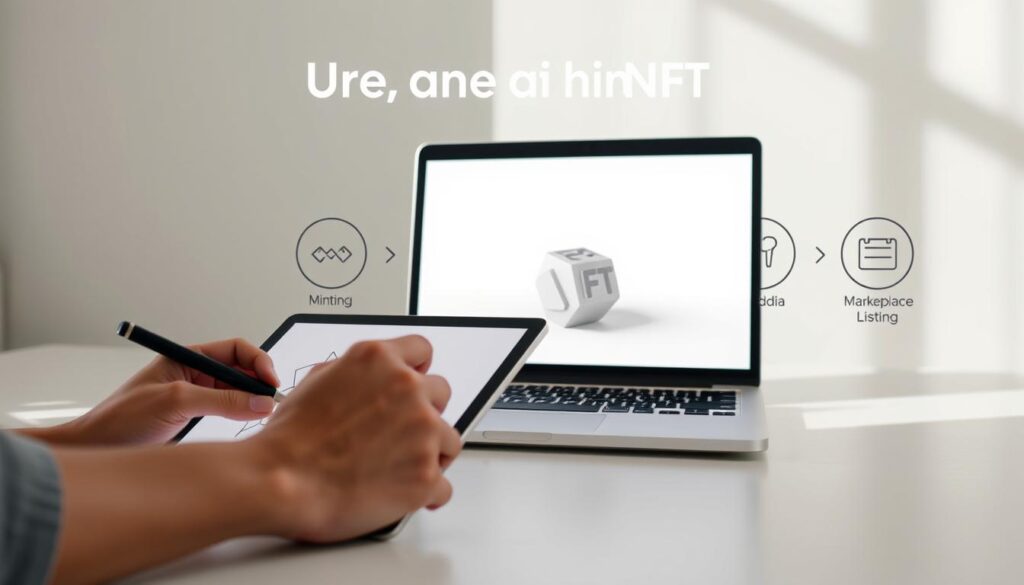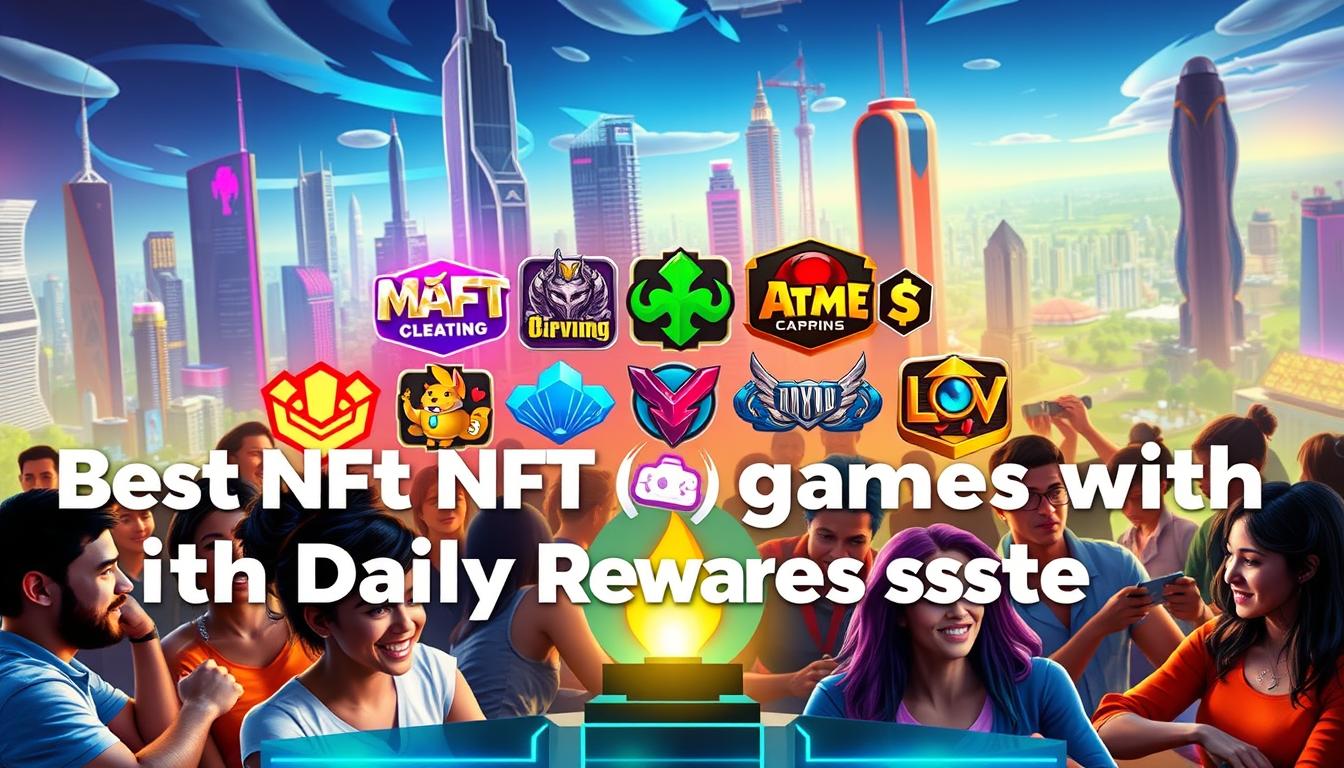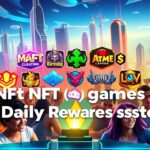Now Reading: Learn How to Earn Crypto by Creating and Selling NFTs
- 01
Learn How to Earn Crypto by Creating and Selling NFTs
Learn How to Earn Crypto by Creating and Selling NFTs

The world of digital art and collectibles has completely changed. Non-fungible tokens, or NFTs, are the reason for this shift. They offer a new way to prove who owns a unique digital item.
This technology has unlocked massive financial potential. In 2021, the NFT market saw sales reach a stunning $17.7 billion. This shows a huge increase from the previous year.
High-profile sales prove what is possible. Beeple’s digital artwork sold for $69 million. Twitter CEO Jack Dorsey’s first tweet sold as an NFT for $2.9 million.
This guide will show you the path into this exciting space. We cover everything from the basics to advanced strategies. You will learn about different ways to generate income with digital assets.
Key Takeaways
- NFTs have revolutionized digital ownership, creating a new class of unique digital assets.
- The market for these tokens experienced explosive growth, with sales hitting billions.
- Creating original digital art is just one of several potential revenue streams available.
- This guide is designed for everyone, from complete beginners to experienced creators.
- Real-world examples demonstrate the significant financial outcomes that are achievable.
- Understanding the difference between NFTs and traditional crypto is key to success.
Introduction to NFTs and Their Financial Potential
The landscape of digital property rights has been reshaped by blockchain-based tokens. This technology enables true ownership of unique digital items. It represents a fundamental shift in how we value creative work.
Understanding the Digital Art Revolution
Non-fungible tokens have transformed the creative economy. Digital artists now maintain control over their work. They can connect directly with collectors worldwide.
Blockchain technology removes traditional gatekeepers from the art world. Creators receive fair compensation through transparent transactions. This system empowers artists of all backgrounds.
Overview of NFT Market Growth
The market for these digital assets has experienced explosive expansion. Sales jumped from $82.5 million in 2020 to $17.7 billion in 2021. This demonstrates substantial financial opportunities.
Multiple blockchain networks now support these tokens. Polygon achieved $22.3 million in weekly volume in 2025. This surpassed Ethereum’s $19.2 million, showing market diversification.
This foundation explains why non-fungible tokens matter financially. It sets the stage for exploring creation methods and selling strategies.
What Are Non-Fungible Tokens?
Unlike traditional cryptocurrencies, non-fungible tokens carry unique properties that make each one distinct. These digital certificates prove who owns a specific item on the blockchain.
Definition and Unique Characteristics
An NFT is a special type of crypto token that certifies authenticity. Each token has a unique identifier like a serial number. This makes every non-fungible token different from all others.
“Non-fungible” means these tokens cannot be swapped one-for-one. Think of a rare baseball card versus a dollar bill. The card’s value depends on rarity and demand, while dollars are interchangeable.
This uniqueness creates verifiable scarcity. The value of each NFT depends on multiple factors. These include rarity, creator reputation, and market interest.
Blockchain Technology and Authenticity
The blockchain acts as a permanent digital ledger. It tracks every ownership change for each token. This creates transparent proof of authenticity that anyone can verify.
This technology eliminates the need for central authorities. The distributed network ensures records cannot be altered. This revolutionary approach provides security and permanence for digital assets.
Non-fungible tokens can represent various items. These include artwork, music, virtual real estate, and collectibles. The technology’s versatility makes it applicable across many fields.
Benefits of Digital Ownership Through NFTs
Non-fungible tokens offer multiple advantages that benefit both content producers and collectors in the digital economy. These unique digital assets provide verifiable proof of ownership that was previously impossible to achieve.
The blockchain creates permanent records of authenticity for each item. This solves the problem of digital content being easily copied and distributed without proper attribution.
Collectors gain access to potentially valuable investments with significant appreciation potential. These digital assets also provide portfolio diversification beyond traditional markets.
Creators benefit from revolutionary royalty systems built into smart contracts. Artists receive automatic payments each time their work resells on secondary markets.
This creates ongoing revenue streams that support sustainable creative careers. Buyers directly support artists by eliminating traditional intermediaries.
Ownership often includes exclusive benefits like private community access and special events. These perks add utility beyond the digital artwork itself.
The technology empowers creators to maintain control while building direct audience relationships. This fosters community engagement and new monetization models.
Step-by-Step Guide for NFT Creation
Building your first non-fungible token requires careful planning and execution across multiple phases. This systematic approach ensures your digital asset meets market standards and collector expectations.
Selecting Your Art Medium
Your creative journey begins with choosing the right format for your digital content. NFTs support various media types, each with unique requirements and audience appeal.
Consider your strengths and passion when selecting a medium. Authentic work resonates better with collectors and typically achieves higher value.

Different platforms support specific file formats and sizes. Prepare your content according to marketplace specifications for smooth minting.
| Media Type | File Formats | Max File Size | Platform Support |
|---|---|---|---|
| Images | PNG, JPG, GIF | 100MB | All major platforms |
| Video | MP4, MOV, WEBM | 500MB | Most platforms |
| Audio | MP3, WAV, FLAC | 100MB | Specialized platforms |
| 3D Models | GLB, GLTF | 200MB | Limited platforms |
Minting Your NFT Token
The minting process converts your digital file into a blockchain-based token. This establishes permanent ownership records and authenticity verification.
Follow platform-specific guidelines when uploading your artwork. Each platform has unique interface features and transaction requirements.
Complete metadata fields thoroughly during this step. Title, description, and properties help collectors understand your artwork’s value proposition.
Finalize the minting transaction to create your unique token. This last step officially registers your creation on the chosen blockchain network.
Choosing the Right NFT Marketplace
Your choice of marketplace significantly impacts the visibility and profitability of your digital assets. Each platform offers different audiences, fee structures, and technical requirements.
Understanding these differences helps you select the best environment for your work. The right decision maximizes your potential for success.
Platform Comparison: OpenSea, Rarible, and NFTBaz
OpenSea dominates as the largest NFT marketplace with millions of users. It supports multiple blockchains including Ethereum and Polygon.
The platform charges a standard 2.5% commission on sales. Its lazy minting feature reduces upfront costs for creators.
Rarible takes a community-driven approach with its RARI governance token. Active users gain voting rights on platform decisions.
This marketplace uses a unique regressive fee structure. Rates range from 0.5% for high-value sales to 7.5% for sales under $100.
NFTBaz emerges as a user-friendly option built on Polygon. It features a built-in wallet with simple email signup.
This design eliminates complex external wallet configuration. The platform offers competitive fees around 2.5%.
| Marketplace | Primary Blockchain | Transaction Fee | Key Feature |
|---|---|---|---|
| OpenSea | Ethereum, Polygon | 2.5% | Largest user base |
| Rarible | Ethereum, Solana | 0.5%-7.5% | Community governance |
| NFTBaz | Polygon | ~2.5% | Built-in wallet |
| Magic Eden | Solana | 0% listing | Solana focus |
| Binance NFT | BNB Chain | 1% | Exchange integration |
Evaluating Fees and User Experience
Transaction costs vary significantly across different platforms. Blockchain choice directly impacts these fees.
Polygon-based marketplaces like NFTBaz offer costs of just cents. Ethereum networks can involve much higher gas fees.
Consider interface intuitiveness and wallet integration complexity. These factors greatly affect your daily experience on each platform.
Mobile accessibility and customer support quality matter for long-term use. Community engagement features also differentiate these marketplaces.
Foundation charges 5% but offers curated high-end exposure. Magic Eden provides 0% listing fees for Solana-based assets.
Your selection should balance cost, audience, and technical comfort. The ideal marketplace matches your specific needs and goals.
Setting Up Your Crypto Wallet for NFT Transactions
Your journey into digital collectibles begins with securing your financial gateway. A cryptocurrency wallet serves as your personal vault for managing digital assets and completing blockchain transactions.
Wallet Options and Internal Setups
Several reliable wallet solutions work seamlessly with NFT platforms. MetaMask offers browser extension and mobile app functionality. Coinbase Wallet provides user-friendly exchange integration. Trust Wallet supports broad token compatibility.
Each marketplace accepts specific wallet types. Always verify compatibility in the platform’s help section. NFTBaz simplifies this process with its built-in wallet system.
Funding your account involves purchasing digital currency from exchanges like Coinbase or Binance.US. Transfer funds to your wallet address using the correct network. Network selection is critical to prevent permanent asset loss.
Security Tips and Best Practices
Protect your digital assets with essential security measures. Store recovery phrases offline in secure locations. Never share private keys with anyone.
Enable two-factor authentication when available. Recognize phishing attempts targeting wallet users. Regular software updates maintain protection against new threats.
Consider hardware wallets for significant holdings. Maintain separate accounts for different purposes. This approach balances accessibility with security.
Preparing Your Digital Art and Content
The final quality of your digital asset directly influences collector interest and perceived value. This preparation phase is critical for making your work stand out.
Spend time refining your creation to ensure it is unique and visually compelling. This effort pays off when potential buyers assess your offerings.
Polishing Your Visual and Audio Assets
Professional presentation distinguishes amateur attempts from market-ready pieces. Focus on technical excellence for your specific medium.
Optimize resolution, color profiles, and composition for visual art. For audio, ensure clear mixing and high-quality file formats.
Conduct final quality checks before uploading. Verify that lighting in 3D renders is perfect and audio levels are balanced.
Crafting Engaging Descriptions
Your description provides essential context for your digital art. A compelling narrative adds depth and emotional resonance.
Explain your inspiration and the creative process behind the work. Detail any symbolism or unique characteristics.
Clear titles capture attention while detailed explanations build connection. Inform buyers about edition size and ownership benefits.
| Asset Type | Recommended Format | Max Size Limit | Key Consideration |
|---|---|---|---|
| Static Image | PNG (Lossless) | 100 MB | High resolution (300 DPI+) |
| Animated Art | GIF or MP4 | 500 MB | Optimal loop length |
| Music Track | WAV or FLAC | 100 MB | Mastered audio quality |
| 3D Model | GLB | 200 MB | Texture optimization |
Real-World Use Cases of NFTs
The practical applications of NFTs extend far beyond digital art galleries. These tokens now serve practical functions across numerous industries. They provide verified ownership for both digital and physical assets.

Sports organizations have embraced this technology through platforms like NBA Top Shot. Fans collect officially licensed basketball moments as digital memorabilia. NFL All Day offers similar football collectibles with authenticated highlights.
These tokens can represent ownership of real-world items too. Luxury goods, vehicles, and real estate now have digital certificates. The blockchain token simplifies transfer and verification processes.
Virtual land in metaverse platforms creates entirely new economies. Users purchase, develop, and monetize parcels in Decentraland and Sandbox. This mirrors real-world property markets in digital spaces.
Utility-focused NFTs include blockchain domain names and event tickets. Licenses, certifications, and patents gain immutability through tokenization. Proof of attendance protocols document participation with timestamps.
Fashion brands create NFT versions of physical products. Musicians tokenize albums and exclusive experiences. Academic credentials stored as tokens prevent forgery.
This diverse collection of applications demonstrates the technology’s maturity. NFTs have evolved from speculative items into versatile tools. They establish ownership and create new business models worldwide.
Effective Strategies for NFT Marketing
Building demand for your NFT collection requires targeted outreach and community engagement strategies. Quality digital assets need visibility to reach potential buyers.
Successful promotion connects your work with interested collectors. It transforms digital creations into sought-after items.
Social Media and Community Engagement
Twitter serves as the central hub for NFT discussions. Use relevant hashtags and participate in Spaces conversations.
Instagram showcases visual appeal for your digital art. Discord builds dedicated communities around your projects.
Share behind-the-scenes content to create authentic connections. Respond to comments and engage with your audience regularly.
Collaborations and Exclusive Releases
Partner with established artists to reach new markets. Combined efforts often produce unique and valuable NFTs.
Limited edition collections create scarcity and urgency. Timed drops encourage immediate action from interested buyers.
Exclusive benefits reward early supporters of your work. These strategies help build lasting relationships in the NFT market.
Fixed Price Sales Versus Auctions
Choosing between a fixed price and an auction format is a critical decision for any digital asset creator. This choice directly impacts how quickly your item sells and its final sale price. Understanding the strengths of each method helps you maximize your success.

Advantages and Disadvantages of Each
A fixed price listing offers predictability and simplicity. Buyers can purchase immediately without waiting for an auction to end. This approach works well for creators with consistent demand.
Fixed price sales provide immediate liquidity. They are ideal for multiple editions or when you have an established pricing history. The main drawback is potentially leaving money on the table if demand surges.
Auctions can generate excitement and higher final prices. Multiple collectors competing often drives the price beyond expectations. This format is perfect for one-of-a-kind pieces with uncertain market value.
However, auctions require a significant time commitment. They typically run for 24 hours to several days. There is also a risk of receiving no bids or a low final price if a reserve is not met.
Different auction types exist. English auctions feature ascending bids. Dutch auctions start high with a descending price. Timed auctions with reserve prices protect your minimum value.
Consider a hybrid approach. Start with an auction for a premium piece to set market value. Then, use fixed pricing for subsequent editions. This strategy balances immediate sales with potential for higher rewards.
Managing Transactions, Royalties, and Fees
Successful digital asset sales depend on a clear understanding of the associated costs and revenue streams. This financial knowledge ensures you price your work correctly and maximize your profits.
Every marketplace charges different fees. These include listing fees, transaction fees, and blockchain gas costs.
Knowing these numbers helps you calculate your actual earnings from a sale. It prevents surprises when you receive your payment.
Automated Royalty Systems
One of the most powerful features for creators is the automated royalty system. This allows you to earn a percentage every time your work is resold.
You set this royalty, typically between 5-10%, during the minting process. The smart contract automatically sends you the commission.
This creates a lasting income stream from your original creation. It rewards you as the value of your work grows over time.
| Marketplace | Transaction Fee | Royalty Enforcement |
|---|---|---|
| OpenSea | 2.5% | Strong |
| Rarible | 0.5% – 7.5% | Variable |
| Binance NFT | 1% | Standard |
| Foundation | 5% | High |
Always choose a platform that strongly supports creator royalties. This protects your long-term financial interest in your digital assets.
Avoiding Common Pitfalls and Scams in NFT Marketplaces
The decentralized nature of NFT platforms creates both opportunities and vulnerabilities that users must understand. Security awareness is essential for protecting your digital assets and financial investments.

Wash trading is a common manipulation tactic. Bad actors artificially inflate prices by repeatedly buying their own items. This creates false demand that can mislead inexperienced buyers.
Phishing attacks target collectors through fake websites and fraudulent messages. These scams attempt to steal wallet credentials and drain accounts. Always verify platform URLs before entering any sensitive information.
Network selection is critical during cryptocurrency transfers. Choosing the wrong blockchain can result in permanently lost assets. Triple-check network settings before confirming any transaction.
Verify project authenticity by checking team credentials and community engagement. Look for verified badges and examine transaction history patterns. Reverse image searches can reveal stolen artwork.
Never share your wallet seed phrase or private keys with anyone. Enable all available security features on your account. Maintain healthy skepticism toward projects promising unrealistic returns.
Thorough due diligence protects both creators and collectors in this space. Continuous education about evolving scam tactics is essential for safe participation.
Exploring Advanced NFT Strategies
Beyond initial minting and sales, the NFT ecosystem offers sophisticated financial tools. These methods provide new utility and income streams for digital asset holders.
Fractional Ownership and NFT Rentals
Fractional ownership breaks expensive digital items into affordable shares. This allows a group of buyers to collectively own a premium collection.
Platforms enable holders to tokenize assets into fungible pieces. This provides liquidity while maintaining shared ownership benefits.
The rental market lets owners lease their digital assets temporarily. Smart contracts manage temporary usage rights and automated payments.
This is particularly valuable for gaming NFTs that provide in-game advantages. It creates a passive income way for asset holders.
Other advanced approaches include using tokens for fundraising. NFTs can represent stakes in projects or future revenue streams.
Collateralization allows using digital assets to secure loans. This provides liquidity without selling appreciated items from your collection.
Experience-based offerings tie ownership to unique virtual events. These strategies demonstrate the evolving utility of digital ownership in the market.
The Role of Blockchain and Cryptocurrency in NFT Success
Blockchain technology serves as the fundamental infrastructure powering the entire NFT ecosystem. This distributed digital ledger creates permanent records of ownership that anyone can verify. The system eliminates the need for central authorities.
Different blockchain networks offer varying benefits for NFT creators. Ethereum pioneered the space with robust standards but sometimes has higher fees. Modern alternatives like Polygon provide faster transactions and lower costs.
Cryptocurrency acts as the native payment method for all NFT activities. Each blockchain uses its own token for transactions – Ether for Ethereum, MATIC for Polygon. These digital currencies facilitate minting, buying, and selling.
Polygon’s efficiency recently demonstrated real market impact. In 2025, Polygon NFT volume reached $22.3 million weekly, surpassing Ethereum’s $19.2 million. This shows how technical advantages drive adoption.
Smart contracts automate crucial functions like royalty payments. Token standards like ERC-721 define how each NFT behaves on the network. Gas fees compensate validators for processing transactions.
Newer networks use energy-efficient proof-of-stake systems. This reduces environmental impact compared to older proof-of-work blockchains. Understanding these basics helps creators choose the right platform.
earn crypto by creating and selling NFTs
Transforming your creative work into a digital asset that generates income involves a clear, actionable process. This section outlines the essential steps to monetize your digital creations effectively.
Step-by-Step Revenue Generation
The most direct path to income starts with turning your original work into a unique token. Follow these key steps to launch your first digital asset sale.
- Fund your wallet to cover transaction fees for the minting process.
- Create a high-quality digital version of your artwork or content.
- Log into your chosen marketplace and upload your item with a compelling title and description.
- Choose your listing type—either a single edition or part of a collection.
- Finalize the creation by reviewing all details and confirming the transaction.
After minting, the next step is to list your token for a sale. Locate it in your collection, click the “sell” button, and set your terms.
Ongoing Income Through Creator Royalties
One revolutionary feature of this ecosystem is the automated royalty system. Configure a percentage (typically 5-10%) during the initial minting.
Smart contracts ensure you receive payments automatically each time your work is resold. This creates a sustainable revenue stream long after the primary sale.
Successful creators often combine primary sales with secondary market royalties. This dual-income model provides both immediate and long-term financial benefits from your digital assets.
Conclusion
Sustainable success in the digital asset space comes from building genuine value over time. This guide has equipped you with comprehensive knowledge for navigating the NFT world effectively.
While high-profile sales capture attention, lasting achievement typically results from consistent work and community engagement. Artists who focus on quality content and authentic connections often see the best long-term results.
Remember to approach this marketplace with realistic expectations and proper risk management. The NFT ecosystem offers multiple pathways, but success requires patience and continuous learning.
Your journey with digital tokens begins now. Start with manageable projects, learn from each experience, and build your reputation gradually. The tools for participation are accessible to anyone willing to invest the time.
FAQ
What is the best NFT marketplace for beginners?
For beginners, platforms like OpenSea and Rarible are excellent choices. They offer user-friendly interfaces and support multiple blockchains. These marketplaces simplify the process of listing your first digital asset for a fixed price or auction.
How do I set up a crypto wallet to sell an NFT?
You need a non-custodial wallet like MetaMask or Coinbase Wallet. Download the wallet, create a new account, and securely store your seed phrase. Then, connect your wallet to your chosen NFT marketplace to manage your collection and transactions.
What are creator royalties in the NFT world?
A> Creator royalties are a percentage of the sale price you earn each time your NFT is sold on the secondary market. This is set by you when you mint the token and is automatically paid by the platform, providing ongoing income from your digital art.
What’s the difference between a fixed price sale and an auction?
A fixed price sale lists your NFT at a set cost for immediate purchase. An auction allows buyers to bid over time, potentially driving the final price higher. Your choice depends on your marketing strategy and goals for the sale.
How can I ensure my digital art is ready for minting?
Polish your visual or audio files to the highest quality. Write a compelling description and title for your work. Ensure you own the intellectual property rights to the content before you proceed to the minting step on the platform.
What are common scams in NFT marketplaces?
A> Be wary of fake customer support accounts, phishing links, and fraudulent duplicate collections. Always verify official website URLs and never share your wallet’s private keys or seed phrase. Transact only through the official marketplace interface.















